Does A Stock Have To Be Registered On A Stock Exchange

A stock substitution, securities exchange, or bourse, is an exchange where stockbrokers and traders can purchase and sell securities, such as shares of stock, bonds, and other financial instruments. Stock exchanges may also provide facilities for the issue and redemption of such securities and instruments and majuscule events including the payment of income and dividends.[ commendation needed ] Securities traded on a stock commutation include stock issued by listed companies, unit of measurement trusts, derivatives, pooled investment products and bonds. Stock exchanges often function as "continuous auction" markets with buyers and sellers consummating transactions via open outcry at a primal location such as the floor of the substitution or past using an electronic trading platform.[1]
To be able to merchandise a security on a certain stock exchange, the security must be listed in that location. Usually, in that location is a central location at to the lowest degree for record keeping, but trade is increasingly less linked to a physical place, every bit modern markets use electronic communication networks, which requite them advantages of increased speed and reduced cost of transactions. Trade on an exchange is restricted to brokers who are members of the exchange. In recent years, various other trading venues, such as electronic advice networks, alternative trading systems and "night pools" have taken much of the trading activeness away from traditional stock exchanges.[2]
Initial public offerings of stocks and bonds to investors is done in the primary market and subsequent trading is washed in the secondary market. A stock exchange is ofttimes the most of import component of a stock market. Supply and need in stock markets are driven by various factors that, as in all free markets, impact the price of stocks (see stock valuation).
There is commonly no obligation for stock to be issued through the stock substitution itself, nor must stock be subsequently traded on an substitution. Such trading may be off exchange or over-the-counter. This is the usual way that derivatives and bonds are traded. Increasingly, stock exchanges are part of a global securities market. Stock exchanges too serve an economic function in providing liquidity to shareholders in providing an efficient ways of disposing of shares.
History [edit]

The term bourse is derived from the 13th-century inn named "Huis ter Beurze" (center) in Bruges. From Dutch-speaking cities of the Low Countries, the term 'beurs' spread to other European states where information technology was corrupted into 'bourse', 'borsa', 'bolsa', 'börse', etc. In England, besides, the term 'bourse' was used betwixt 1550 and 1775, somewhen giving style to the term 'majestic substitution'.

In that location is little consensus among scholars as to when corporate stock was first traded. Some run across the key issue as the Dutch East India Company's founding in 1602,[three] while others point to earlier developments (Bruges, Antwerp in 1531 and in Lyon in 1548). The start book in history of securities exchange, the Defoliation of Confusions, was written past the Dutch-Jewish trader Joseph de la Vega and the Amsterdam Stock Substitution is often considered the oldest "modern" securities marketplace in the world.[4] On the other mitt, economist Ulrike Malmendier of the University of California at Berkeley argues that a share market existed as far back as ancient Rome, that derives from Etruscan "Argentari". In the Roman Republic, which existed for centuries before the Empire was founded, there were societates publicanorum, organizations of contractors or leaseholders who performed temple-building and other services for the regime. One such service was the feeding of geese on the Capitoline Hill as a reward to the birds after their honking warned of a Gallic invasion in 390 B.C. Participants in such organizations had partes or shares, a concept mentioned various times past the statesman and orator Cicero. In ane spoken language, Cicero mentions "shares that had a very loftier price at the time". Such evidence, in Malmendier's view, suggests the instruments were tradable, with fluctuating values based on an system'southward success. The societas declined into obscurity in the time of the emperors, equally most of their services were taken over past direct agents of the state. Tradable bonds equally a usually used type of security were a more recent innovation, spearheaded by the Italian city-states of the belatedly medieval and early Renaissance periods.[5]

Joseph de la Vega, also known as Joseph Penso de la Vega and by other variations of his proper name, was an Amsterdam trader from a Spanish Jewish family and a prolific author as well as a successful man of affairs in 17th-century Amsterdam. His 1688 volume Defoliation of Confusions [6] explained the workings of the city's stock market. Information technology was the primeval book about stock trading and inner workings of a stock market, taking the form of a dialogue betwixt a merchant, a shareholder and a philosopher, the book described a market that was sophisticated but as well prone to excesses, and de la Vega offered advice to his readers on such topics equally the unpredictability of market shifts and the importance of patience in investment.

In England, King William Three sought to modernize the kingdom'due south finances to pay for its wars, and thus the first government bonds were issued in 1693 and the Bank of England was gear up upwardly the post-obit year. Soon thereafter, English articulation-stock companies began going public.
London'southward commencement stockbrokers, nonetheless, were barred from the former commercial center known as the Purple Exchange, reportedly because of their rude manners. Instead, the new trade was conducted from java houses along Substitution Aisle. By 1698, a broker named John Castaing, operating out of Jonathan's Coffee House, was posting regular lists of stock and commodity prices. Those lists mark the beginning of the London Stock Exchange.[7]
One of history's greatest fiscal bubbling occurred around 1720. At the center of it were the South Ocean Company, gear up in 1711 to conduct English trade with South America, and the Mississippi Visitor, focused on commerce with France'south Louisiana colony and touted by transplanted Scottish financier John Law, who was acting in effect every bit French republic's primal banker. Investors snapped up shares in both, and any else was bachelor. In 1720, at the top of the mania, in that location was even an offering of "a company for carrying out an undertaking of slap-up advantage, but nobody to know what it is".
By the end of that aforementioned year, share prices had started collapsing, every bit it became clear that expectations of imminent wealth from the Americas were overblown. In London, Parliament passed the Chimera Deed, which stated that simply royally chartered companies could event public shares. In Paris, Law was stripped of office and fled the land. Stock trading was more limited and subdued in subsequent decades. Yet the market place survived, and by the 1790s shares were being traded in the young Usa. On May 17, 1792, the New York Stock Exchange opened under a platanus occidentalis (buttonwood tree) in New York City, equally 24 stockbrokers signed the Buttonwood Agreement, agreeing to merchandise five securities nether that buttonwood tree.[eight]

Bombay Stock Exchange was started by Premchand Roychand in 1875.[9] While BSE Limited is now synonymous with Dalal Street, it was not e'er so. In the 1850s, five stock brokers gathered together under a Banyan tree in front of Mumbai Boondocks Hall, where Horniman Circle is at present situated.[10] A decade later, the brokers moved their location to another leafy setting, this time nether banyan trees at the junction of Meadows Street and what was so chosen Esplanade Road, now Mahatma Gandhi Road. With a rapid increase in the number of brokers, they had to shift places repeatedly. At last, in 1874, the brokers constitute a permanent location, the one that they could call their own. The brokers group became an official arrangement known equally "The Native Share & Stock Brokers Association" in 1875.[xi]
The Bombay Stock Substitution continued to operate out of a building well-nigh the Town Hall until 1928. The present site virtually Horniman Circumvolve was caused by the substitution in 1928, and a building was synthetic and occupied in 1930. The street on which the site is located came to be chosen Dalal Street in Hindi (pregnant "Broker Street") due to the location of the exchange.
On 31 Baronial 1957, the BSE became the beginning stock exchange to be recognized by the Indian Government under the Securities Contracts Regulation Act. Structure of the present building, the Phiroze Jeejeebhoy Towers at Dalal Street, Fort area, began in the tardily 1970s and was completed and occupied by the BSE in 1980. Initially named the BSE Towers, the name of the edifice was changed soon after occupation, in memory of Sir Phiroze Jamshedji Jeejeebhoy, chairman of the BSE since 1966, following his decease.
In 1986, the BSE developed the South&P BSE SENSEX index, giving the BSE a means to measure the overall functioning of the exchange. In 2000, the BSE used this index to open its derivatives market, trading S&P BSE SENSEX futures contracts. The evolution of S&P BSE SENSEX options along with equity derivatives followed in 2001 and 2002, expanding the BSE's trading platform.
Historically an open outcry flooring trading substitution, the Bombay Stock Substitution switched to an electronic trading organisation developed by Cmc ltd. in 1995. It took the exchange only 50 days to brand this transition. This automated, screen-based trading platform called BSE On-Line Trading (BOLT) had a capacity of 8 one thousand thousand orders per twenty-four hour period. Now BSE has raised capital past issuing shares and equally on 3 May 2017 the BSE share which is traded in NSE only closed with ₹999.[12]
Roles [edit]
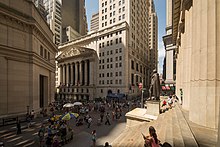
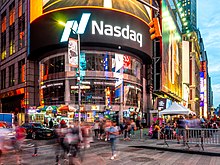


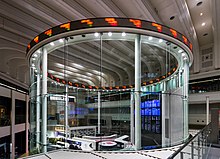



London Stock Exchange in London, United kingdom of great britain and northern ireland is the eighth-largest stock substitution in the world, largest non-European union European Stock Exchange and second largest in Europe.
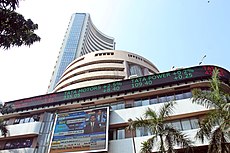
Bombay Stock Exchange in Mumbai, Bharat is the 9th-largest stock substitution in the world, oldest and 5th-largest in Asia, largest in India. It is the fastest stock exchange in the world
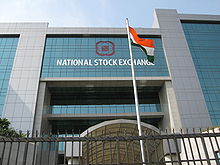

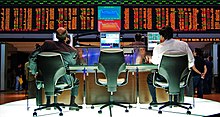

Stock exchanges have multiple roles in the economy. This may include the following:[13]
Raising capital for businesses [edit]
Besides the borrowing capacity provided to an individual or firm past the banking system, in the form of credit or a loan, a stock exchange provides companies with the facility to heighten capital letter for expansion through selling shares to the investing public.[14]
Capital intensive companies, particularly high tech companies, ever need to raise high volumes of uppercase in their early stages. For this reason, the public market provided past the stock exchanges has been ane of the nigh of import funding sources for many capital intensive startups. In the 1990s and early 2000s, hi-tech listed companies experienced a boom and bosom in the world's major stock exchanges. Since and then, it has been much more demanding for the high-tech entrepreneur to take his/her visitor public, unless either the company is already generating sales and earnings, or the company has demonstrated credibility and potential from successful outcomes: clinical trials, market research, patent registrations, etc. This is quite dissimilar from the state of affairs of the 1990s to early-2000s menses, when a number of companies (particularly Cyberspace nail and biotechnology companies) went public in the about prominent stock exchanges around the world in the total absenteeism of sales, earnings, or any type of well-documented promising result. Though it's non every bit common, it still happens that highly speculative and financially unpredictable how-do-you-do-tech startups are listed for the first time in a major stock exchange. Additionally, in that location are smaller, specialized entry markets for these kind of companies with stock indexes tracking their performance (examples include the Alternext, CAC Small, SDAX, TecDAX).
Alternatives to stock exchanges for raising majuscule [edit]
Enquiry and Development express partnerships [edit]
Companies accept also raised significant amounts of capital letter through R&D express partnerships. Tax constabulary changes that were enacted in 1987 in the U.s.a. changed the tax deductibility of investments in R&D limited partnerships. In order for a partnership to be of interest to investors today, the cash on cash render must be high enough to entice investors.
Venture majuscule [edit]
A general source of capital letter for startup companies has been venture uppercase. This source remains largely available today, but the maximum statistical corporeality that the venture company firms in aggregate will invest in whatsoever ane company is not limitless (information technology was approximately $fifteen meg in 2001 for a biotechnology company).
Corporate partners [edit]
Another culling source of cash for a private company is a corporate partner, commonly an established multinational visitor, which provides capital for the smaller company in render for marketing rights, patent rights, or equity. Corporate partnerships have been used successfully in a large number of cases.
Mobilizing savings for investment [edit]
When people draw their savings and invest in shares (through an initial public offer or the seasoned disinterestedness offering of an already listed company), it unremarkably leads to rational allocation of resource because funds, which could have been consumed, or kept in idle deposits with banks, are mobilized and redirected to help companies' direction boards finance their organizations. This may promote business action with benefits for several economic sectors such as agriculture, commerce and industry, resulting in stronger economic growth and higher productivity levels of firms.
Facilitating acquisitions [edit]
Companies view acquisitions as an opportunity to aggrandize product lines, increment distribution channels, hedge against volatility, increase their market share, or acquire other necessary business assets. A takeover bid or mergers and acquisitions through the stock market is 1 of the simplest and nearly common means for a company to grow past acquisition or fusion.
Turn a profit sharing [edit]
Both casual and professional stock investors, as large equally institutional investors or as pocket-sized as an ordinary middle-class family, through dividends and stock price increases that may consequence in capital gains, share in the wealth of profitable businesses. Unprofitable and troubled businesses may result in capital letter losses for shareholders.
Corporate governance [edit]
By having a broad and varied scope of owners, companies generally tend to improve management standards and efficiency to satisfy the demands of these shareholders and the more stringent rules for public corporations imposed by public stock exchanges and the regime. This improvement can exist attributed in some cases to the price mechanism exerted through shares of stock, wherein the price of the stock falls when management is considered poor (making the firm vulnerable to a takeover by new management) or rises when management is doing well (making the firm less vulnerable to a takeover). In addition, publicly listed shares are subject to greater transparency and then that investors can make informed decisions nearly a purchase. Consequently, it is alleged that public companies (companies that are owned by shareholders who are members of the full general public and trade shares on public exchanges) tend to have better management records than privately held companies (those companies where shares are not publicly traded, often endemic by the company founders, their families and heirs, or otherwise by a minor group of investors).
Despite this claim, some well-documented cases are known where information technology is alleged that in that location has been considerable slippage in corporate governance on the part of some public companies, particularly in the cases of accounting scandals. The policies that led to the dot-com bubble in the late 1990s and the subprime mortgage crunch in 2007–08 are also examples of corporate mismanagement. The mismanagement of companies such as Pets.com (2000), Enron (2001), I.Tel (2001), Sunbeam Products (2001), Webvan (2001), Adelphia Communications Corporation (2002), MCI WorldCom (2002), Parmalat (2003), American International Group (2008), Carry Stearns (2008), Lehman Brothers (2008), Full general Motors (2009) and Satyam Reckoner Services (2009) all received plenty of media attention.
Many banks and companies worldwide utilise securities identification numbers (ISIN) to identify, uniquely, their stocks, bonds and other securities. Calculation an ISIN code helps to distinctly identify securities and the ISIN system is used worldwide past funds, companies, and governments.
However, when poor fiscal, upstanding or managerial records get public, stock investors tend to lose coin as the stock and the company tend to lose value. In the stock exchanges, shareholders of underperforming firms are often penalized by significant share price decline, and they tend equally well to dismiss incompetent management teams.
Creating investment opportunities for pocket-size investors [edit]
Every bit opposed to other businesses that require huge capital letter outlay, investing in shares is open to both the large and small stock investors as minimum investment amounts are minimal. Therefore, the stock commutation provides the opportunity for small investors to own shares of the aforementioned companies as large investors.
Regime uppercase-raising for development projects [edit]
Governments at various levels may determine to borrow coin to finance infrastructure projects such as sewage and water handling works or housing estates by selling another category of securities known as bonds. These bonds tin be raised through the stock exchange whereby members of the public purchase them, thus loaning money to the government. The issuance of such bonds tin can obviate, in the curt term, straight taxation of citizens to finance development—though by securing such bonds with the total faith and credit of the government instead of with collateral, the regime must eventually revenue enhancement citizens or otherwise heighten additional funds to make whatsoever regular coupon payments and refund the principal when the bonds mature.
Barometer of the economy [edit]
At the stock exchange, share prices ascent and fall depending, largely, on economic forces. Share prices tend to rise or remain stable when companies and the economy in general show signs of stability and growth. A recession, depression, or financial crisis could eventually atomic number 82 to a stock market crash. Therefore, the motility of share prices and in general of the stock indexes tin can be an indicator of the general tendency in the economy.
Listing requirements [edit]
Each stock substitution imposes its own listing requirements upon companies that want to exist listed on that exchange. Such conditions may include minimum number of shares outstanding, minimum market capitalization, and minimum almanac income.
Examples of list requirements [edit]
The listing requirements imposed by some stock exchanges include:
- New York Stock Substitution: the New York Stock Exchange (NYSE) requires a company to take issued at least ane.one meg shares of stock worth $40 million and must accept earned more than than $10 million over the last three years.[15]
- NASDAQ Stock Commutation: NASDAQ requires a company to have issued at least 1.25 million shares of stock worth at least $lxx million and must take earned more than $eleven million over the last three years.[16]
- London Stock Exchange: the master market place of the London Stock Substitution requires a minimum marketplace capitalization (£700,000), iii years of audited financial statements, minimum public bladder (25%) and sufficient working uppercase for at least 12 months from the appointment of listing.
- Bombay Stock Exchange: Bombay Stock Commutation (BSE) requires a minimum market capitalization of ₹250 million (US$iii.3 meg) and minimum public float equivalent to ₹100 million (US$1.3 one thousand thousand).[17]
Buying [edit]
Stock exchanges originated as mutual organizations, owned by its fellow member stockbrokers. However, the major stock exchanges have demutualized, where the members sell their shares in an initial public offering. In this manner the mutual organization becomes a corporation, with shares that are listed on a stock exchange. Examples are Australian Securities Exchange (1998), Euronext (merged with New York Stock Exchange), NASDAQ (2002), Bursa Malaysia (2004), the New York Stock Exchange (2005), Bolsas y Mercados Españoles, and the São Paulo Stock Substitution (2007).
The Shenzhen Stock Exchange and Shanghai Stock Exchange can be characterized every bit quasi-state institutions insofar as they were created past government bodies in China and their leading personnel are directly appointed by the China Securities Regulatory Commission.
Another example is Tashkent Stock Commutation established in 1994, iii years after the collapse of the Soviet Union, mainly state-owned but has a class of a public corporation (articulation-stock company). Korea Exchange (KRX) owns 25% less i share of the Tashkent Stock Commutation.[18]
In 2018, there were 15 licensed stock exchanges in the The states, of which thirteen actively traded securities. All of these exchanges were endemic by iii publicly traded multinational companies, Intercontinental Exchange, Nasdaq, Inc., and Cboe Global Markets, except one, IEX.[19] [20] In 2019, a group of financial corporations appear plans to open a members endemic exchange, MEMX, an ownership structure similar to the mutual organizations of earlier exchanges.[21] [19]
Other types of exchanges [edit]
In the 19th century, exchanges were opened to merchandise forward contracts on commodities. Exchange traded forrard contracts are called futures contracts. These commodity markets later started offering hereafter contracts on other products, such every bit interest rates and shares, also as options contracts. They are now mostly known as futures exchanges.
Run into besides [edit]
- Auction
- Capital market
- Commodities exchange
- Corporate governance
- Federation of Euro-Asian Stock Exchanges
- Financial regulation
- Histoire des bourses de valeurs (French)
- International Organization of Securities Commissions
- Securities marketplace participants (United States)
- Shareholder
- Stag profit
- Stock exchanges for developing countries
- Stock investor
- Stock market
- Stock market data systems
- World Federation of Exchanges
Lists:
- List of stock exchanges
- Listing of European stock exchanges
- Listing of stock exchanges in the Americas
- List of African stock exchanges
- List of stock exchanges in Western Asia
- List of S Asian stock exchanges
- Listing of East Asian stock exchanges
- List of Southeast Asian stock exchanges
- List of stock exchanges in Oceania
- List of countries without a stock commutation
- Listing of stock market indices
- List of financial regulatory authorities by country
- List of Swiss financial market legislation
References [edit]
- ^ Lemke and Lins, Soft Dollars and Other Trading Activities, §2:three (Thomson West, 2013-2014 ed.).
- ^ Lemke and Lins, Soft Dollars and Other Trading Activities, §§2:25 - 2:30 (Thomson W, 2013-2014 ed.).
- ^ BEATTIE, ANDREW (xiii December 2017). "What Was the Start Company to Issue Stock?". Investopedia.
- ^ Braudel, Fernand (1983). Wheels of Commerce: Civilisation & Capitalism 15th-18th Century. New York: Harper & Row. ISBN0060150912.
- ^ Stringham, Edward Peter; Curott, Nicholas A.: On the Origins of Stock Markets [Function Four: Institutions and Organizations; Affiliate fourteen], pp. 324-344, in The Oxford Handbook of Austrian Economic science, edited by Peter J. Boettke and Christopher J. Coyne. (Oxford University Press, 2015, ISBN 978-0199811762). Edward P. Stringham & Nicholas A. Curott: "Business ventures with multiple shareholders became pop with commenda contracts in medieval Italia (Greif, 2006, p. 286), and Malmendier (2009) provides evidence that shareholder companies date dorsum to aboriginal Rome. Nevertheless the title of the earth's first stock market deservedly goes to that of seventeenth-century Amsterdam, where an active secondary market in company shares emerged. The ii major companies were the Dutch Eastward India Company and the Dutch Due west India Company, founded in 1602 and 1621. Other companies existed, but they were non equally large and constituted a small portion of the stock marketplace (State of israel [1989] 1991, 109–112; Dehing and 't Hart 1997, 54; dela Vega [1688] 1996, 173)."
- ^ De la Vega, Joseph, Confusion de Confusiones (1688), Portions Descriptive of the Amsterdam Stock Commutation, introduction past Hermann Kellenbenz, Baker Library, Harvard Graduate School of Business Assistants (1957)
- ^ "Stockbroker 101 - A Cool History". Stockbroker 101.
- ^ "History of the NY Stock Exchange". Library of Congress. May 2004.
- ^ "BSE may set some other record, become an official tourist spot". The New Indian Express. Printing Trust of Republic of india. half-dozen October 2017. Retrieved 4 November 2021.
- ^ "THE Contour OF Bombay STOCK EXCHANGE Limited".
- ^ "The History of Bombay Stock Exchange". YouTube. Archived from the original on 30 Oct 2021.
- ^ "BSEIndia". BSEIndia. Archived from the original on 22 January 2014. Retrieved 28 July 2010.
- ^ Diamond, Peter A. (1967). "The Part of a Stock Marketplace in a General Equilibrium Model with Technological Doubtfulness". American Economical Review. 57 (4): 759–776. JSTOR 1815367.
- ^ Gilson, Ronald J.; Black, Bernard S. (1998). "Venture Capital and the Structure of Capital Markets: Banks Versus Stock Markets". Journal of Financial Economics. 47. doi:ten.2139/ssrn.46909. S2CID 154673504.
- ^ "Overview of NYSE Quantitative Initial Listing Standards" (PDF). New York Stock Exchange.
- ^ "Applications, Notifications & Guides - Nasdaq Listing Middle". NASDAQ.
- ^ "Bombay Stock Exchange". Bombay Stock Commutation.
- ^ "Stages of the Republican Stock Exchange". Tashkent Stock Exchange.
- ^ a b Lahiri, Diptendu (7 January 2019). "Major Wall Street players plan exchange to challenge NYSE, Nasdaq". Reuters.
- ^ Ramsay, John (23 May 2018). "Competition among exchanges has reached a new low, and information technology'southward dangerous for the stock market". Business Insider. (for contempo history see also, "NYSE, Nasdaq and...? Get to Know the U.S.'south Stock Exchanges, Part 1". Financial Industry Regulatory Potency. 17 Baronial 2016. , and "Go to Know the U.S.'s Major Stock Exchanges, Role ii". Fiscal Manufacture Regulatory Authorisation. 17 August 2016.
- ^ Osipovich, Alexander (7 January 2019). "Wall Street Firms Plan New Exchange to Challenge NYSE, Nasdaq". The Wall Street Journal.
External links [edit]
- Stock exchange at Curlie
Source: https://en.wikipedia.org/wiki/Stock_exchange
Posted by: millerandrom.blogspot.com


0 Response to "Does A Stock Have To Be Registered On A Stock Exchange"
Post a Comment